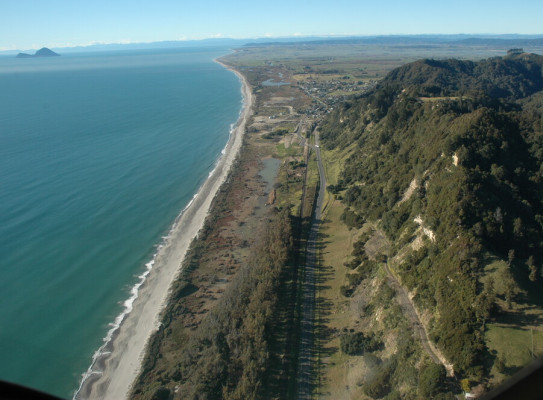Analysis of data pins down reason behind BOP quake swarm

Scientists using a combination of satellite images, GPS data and conventional survey information dating back to the 1950s have uncovered the reason for a swarm of several thousand small earthquakes between 2004 and 2011 around the coastal Bay of Plenty town of Matata.
The three streams of data show that an area of land around Matata roughly 20km by 20km, about half of which is offshore, has been pushed up by about 40cm since 1950.
An episode of marked uplift between 2004 and 2011 corresponds to the period of the Matata earthquake swarm.
Until now the cause of the swarm was thought to be tectonic. Most of the quakes were between magnitude 2.0 and 4.0 and occurred at depths between 2km and 8km. The new finding concludes the swarm was caused by the growth of a previously unrecognised magma chamber under the Bay of Plenty coast.
During this period molten or semi-molten rock was being pushed up from below and caused land around Matata to uplift by about 1cm a year. As the magma moves in the sub-surface, it causes the surrounding rock to deform and break, resulting in small earthquakes.
Using modelling, scientists have concluded a magma body lies about 9km below the surface. Since 1950, it has grown in volume by 0.2 cubic kilometres or equivalent in size to about 80,000 Olympic swimming pools.
Scientists say the presence of a magma body does not mean an eruption might be imminent and it has not changed the volcanic hazard of the Bay of Plenty region.
The research has just been published in the science journal Science Advances. It is titled 'Off-axis magmatism along a subaerial back-arc rift.'
Lead author Ian Hamling, a satellite image specialist at GNS Science, said the finding highlighted that accumulation of magma was not always where we might expect based on the location of volcanoes at the surface.

Our modelling points to the presence of a magma chamber in an area where there has been no active volcanism for about 400,000 years.
He added that bodies of magma were reasonably common under large areas of the central North Island, and identifying another magma accumulation was not a huge surprise.
"There is every possibility the magma body under the Bay of Plenty coast had been there for centuries, and possibly even longer."
To model the magma body at depth scientists used a combination of modern GPS data and conventional survey data dating from the 1950s. They augmented this with satellite radar data of the North Island, which has been collected from about 2003 onwards.
Observations of inflating magma bodies at depth were a reasonably common feature of volcanic areas worldwide, especially since the advent of highly accurate GPS and satellite measurements which can pick up small amounts of surface inflation and subsidence.
There were cases overseas where the surface inflation rate had been considerably faster than at the Bay of Plenty coast, but with no associated volcanic unrest, Dr Hamling said.
While there is absolutely no evidence pointing to volcanic unrest in coastal Bay of Plenty, this finding underlines the fact that we live in a geologically active country where it pays to be prepared.
Dr Hamling hoped funding would be available to continue this research so scientists could more accurately model the size and depth of the magma body, and keep a lookout for any changes that might occur at depth.
The authors of the science paper would like to thank the European and Japanese Space Agencies for access to satellite images and GeoNet for the GPS data. The research was supported by public good research funding from the New Zealand Government, with additional support from the Natural Hazards Research Platform, the Earthquake Commission, and Land Information New Zealand.